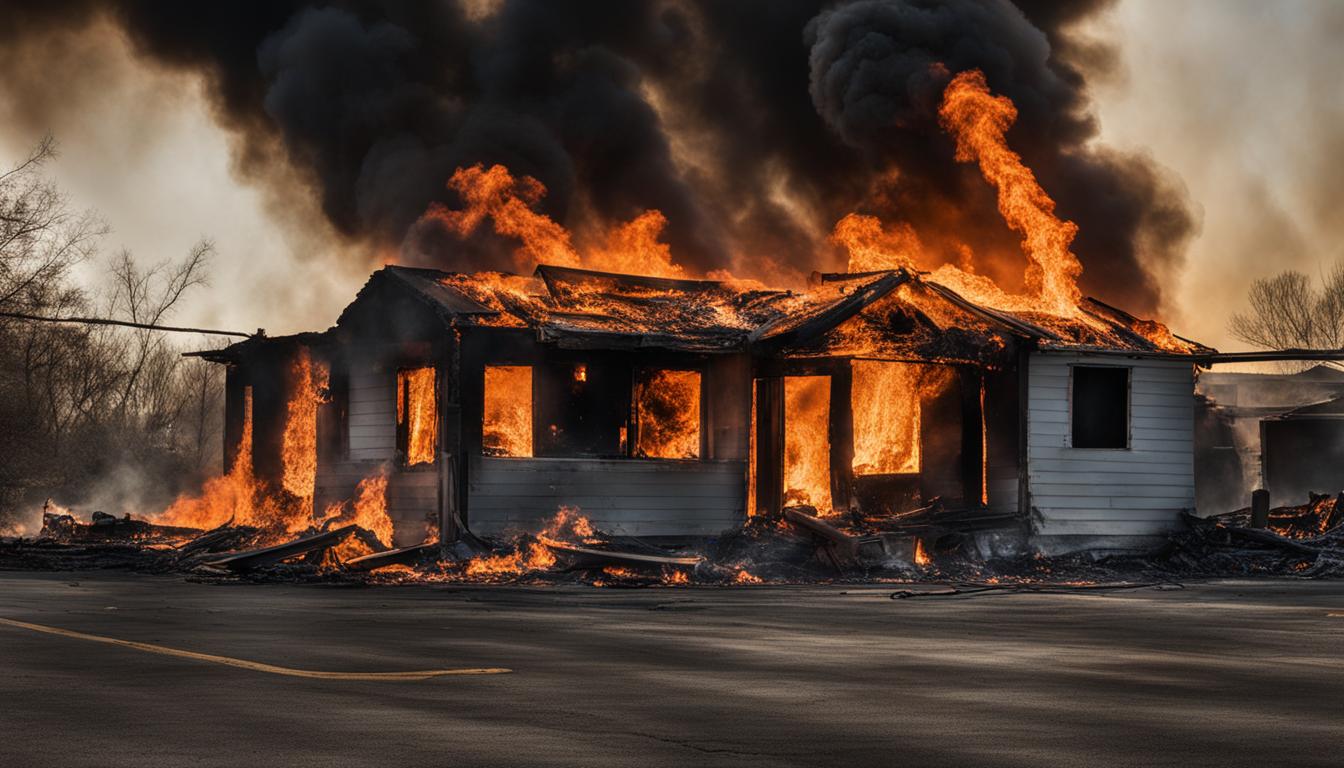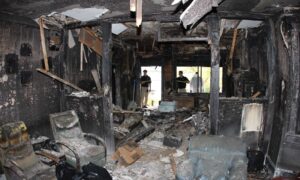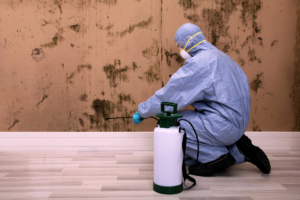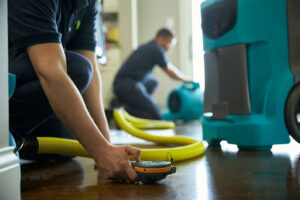If you have experienced fire damage, your health may be at risk. The toxic substances released during a fire can impact your well-being, making it crucial to understand the potential dangers. In this section, we will examine the health hazards associated with fire damage and explain how it can affect your health.
Key Takeaways:
- Fire damage can release toxic substances that can harm your health.
- Smoke inhalation during a fire can lead to respiratory problems, lung damage, and irritation of the eyes, nose, and throat.
- Fire damage can expose you to hidden dangers, such as hazardous materials and toxins in building materials.
- Improving indoor air quality after a fire is essential for your health and well-being.
- Professional assistance is necessary for fire damage restoration to ensure safety and minimize health risks.
What Makes Fire Damage Toxic?
Fire damage can release various toxic substances into the air, posing a significant health risk. Exposure to toxic substances in fire damage can cause several health issues, including respiratory problems, nausea, and fatigue.
The most common toxic substances in fire damage are:
| Toxic Substance | Health Effects |
|---|---|
| Carbon monoxide | Reduced oxygen supply to the body, headache, dizziness, confusion, and nausea |
| Formaldehyde | Irritation of the eyes, nose, throat, respiratory problems, and cancer |
| Volatile Organic Compounds (VOCs) | Respiratory problems, dizziness, fatigue, and nausea |
Smoke inhalation is a significant health risk during fire damage, leading to immediate and long-term side effects. Inhalation of smoke can cause heart and lung damage, and result in oxygen deprivation in your body. It can affect all age groups, but the elderly, pregnant women, and young children are more vulnerable to the side effects of smoke inhalation.
Fire damage can also release toxic byproducts in the atmosphere due to chemical reactions that occur during a fire. These byproducts can further increase the danger of fire damage and pose health risks.
Protect yourself and your family by taking necessary precautions and avoiding exposure to toxic substances during and after fire damage.
Health Risks of Smoke Inhalation
Smoke inhalation is a serious health concern when exposed to fires. It can cause a range of respiratory problems such as coughing, wheezing, and shortness of breath. Prolonged exposure to smoke can lead to lung damage and other long-term health issues.
The substances present in smoke can also irritate your eyes, nose, and throat, causing discomfort and inflammation. This can make it difficult to breathe, affecting your overall health and well-being.
Children, elderly people, and individuals with pre-existing respiratory conditions are particularly vulnerable to the health risks of smoke inhalation. It is crucial to seek medical attention immediately if you experience any symptoms following exposure to smoke.
To minimize the health risks of smoke inhalation, it is important to evacuate the area immediately if you notice smoke or fire. Use protective gear, such as a face mask or respirator, to avoid inhaling harmful substances during cleanup or restoration after fire damage.
The Hidden Dangers of Fire Damage
While the immediate health risks of smoke inhalation are well-known, fire damage can also expose you to hidden dangers. In older structures, there is a risk of hazardous materials like asbestos and lead being present. During a fire, these materials can become friable, and their tiny particles can become airborne. Inhaling these particles can cause lasting damage to your lungs and overall health.
| Building Material | Toxins Released During a Fire |
|---|---|
| Insulation | Formaldehyde, fiberglass, asbestos |
| Paint | Lead, volatile organic compounds (VOCs) |
| Carpeting | Flame retardants, VOCs, mold |
| Electronics | Brominated flame retardants, heavy metals |
Moreover, many building materials, such as insulation and carpeting, contain toxins that can be released into the air during a fire. Inhaling these toxins can have immediate and long-term health effects. Examples of these toxins include formaldehyde, VOCs, and mold.
It’s essential to exercise caution and take proper safety measures when cleaning up after fire damage. Protection gear should be used to prevent exposure to toxic materials. If you’re not sure whether it’s safe to handle a specific material, it’s best to consult a professional.
Fire Damage and Indoor Air Quality
After a fire, it’s not just the visible damage that needs attention. The quality of the indoor air can be adversely affected, posing significant health risks. Smoke and soot particles can linger and continue to release toxic chemicals, even in areas unaffected by the flames. To keep the air safe, here are some steps you can take:
- Avoid exposing yourself to the air in fire-damaged areas. Soot and smoke particles can cause respiratory problems, so limit your exposure as much as possible. Wear a mask and gloves if necessary.
- Use air purification methods. Air purifiers with HEPA filters can remove particles and odors, significantly improving the air quality. Ensure that the air purifier has a Clean Air Delivery Rate (CADR) that matches the size of the room.
- Professional testing for indoor air quality after fire damage. Professional testing can be done to ensure your environment is safe and free of toxic substances. This is especially important if you plan on moving back in after the restoration process is complete.
By taking these steps, you can ensure that the air quality in your home or building is safe and free from harmful toxins.
Health Concerns When Cleaning Up After a Fire
After a fire, cleaning up is essential to restore your home or building to its pre-fire state, but it also involves risks to your health, making it important to take precautions. Exposure to toxic substances such as ash, soot, and chemicals from burnt materials can lead to respiratory problems, skin irritation, and gastrointestinal issues.
To avoid exposure to these substances, it is crucial to wear protective gear while cleaning up. This includes gloves, masks, goggles, and protective clothing. These items should cover your entire body and be made of non-porous materials to minimize contact with hazardous materials.
In addition to toxic substances, mold growth is a common problem after fire damage. Standing water and moist areas create suitable conditions for mold growth, which can have serious health consequences such as asthma, allergies, and respiratory infections.
| Steps to prevent mold growth |
|---|
| 1. Remove standing water and dry out all areas thoroughly. |
| 2. Use a dehumidifier or air conditioner to reduce moisture levels. |
| 3. Dispose of any porous materials that cannot be thoroughly disinfected. |
| 4. Clean and disinfect all affected surfaces with a solution of water and bleach or another appropriate disinfectant. |
If you are unsure about how to safely clean up after fire damage, it is best to seek professional assistance. A certified restoration company has the expertise, tools, and protective gear to handle hazardous materials safely.
Seeking Professional Assistance for Fire Damage Restoration
After a fire, seeking professional assistance for fire damage restoration is crucial to ensure safety and minimize health risks. Trained professionals have the expertise and equipment necessary to assess the extent of the damage and determine the best course of action for restoring your property.
Professional fire damage restoration companies prioritize safety precautions to protect both you and your property. They will typically begin with a thorough structural assessment to ensure that the building is safe to enter and work on.
During the restoration process, professionals will wear appropriate protective gear to minimize exposure to toxins and contaminants, such as gloves, goggles, and respirators. They will also take measures to ensure that the area is properly ventilated.
Furthermore, professional fire damage restoration companies have the knowledge and tools required to rid your property of lingering smoke, soot, and other hazardous substances that may be present. They can also advise you on proper air purification methods and conduct professional testing to ensure that the indoor air quality is safe.
Overall, seeking professional assistance for fire damage restoration can provide you with peace of mind and help minimize the health risks associated with fire damage. Don’t hesitate to reach out to trained professionals in the event of a fire emergency.
Call Emrick Services today at 1.502.306.3341 for professional fire damage restoration services.
Conclusion
You now understand that fire damage can release toxic substances and pose health risks, making it crucial to take necessary precautions. To protect your health and well-being, consider seeking professional assistance for fire damage restoration and wear proper protective gear when cleaning up after a fire. Improving indoor air quality through air purification methods and professional testing is also essential. Keep in mind the potential presence of hazardous materials like asbestos and lead in older structures, and the risk of mold growth in the aftermath of fire damage. By taking these precautions, you can minimize the impact of fire damage toxicity on your health.
FAQ
Is fire damage toxic? What are the health hazards?
Yes, fire damage can be toxic. The combustion process releases a variety of harmful substances, including carbon monoxide, formaldehyde, and volatile organic compounds (VOCs). These can have adverse effects on your health, such as respiratory problems, lung damage, and irritation of the eyes, nose, and throat.
What makes fire damage toxic?
Fire damage releases toxic substances into the air, primarily through smoke inhalation. The burning of materials can generate carbon monoxide and other chemicals that are harmful to the human body. Additionally, chemical reactions that occur during a fire can produce toxic byproducts.
What are the health risks of smoke inhalation?
Smoke inhalation can lead to various health issues, including respiratory problems, lung damage, and irritation of the respiratory system. Prolonged exposure to smoke can also increase the risk of developing chronic respiratory conditions and other long-term health complications.
Are there hidden dangers in fire damage?
Yes, beyond the immediate health risks of smoke inhalation, fire damage can expose you to hidden dangers. Older structures may contain hazardous materials like asbestos and lead, which can become airborne during a fire. Additionally, burning building materials can release toxins that pose health risks.
How does fire damage affect indoor air quality?
Fire damage significantly impacts indoor air quality even after the fire has been extinguished. The smoke and chemicals released during a fire can linger in the air and contaminate surfaces. To improve air quality, it is essential to use air purification methods and consider professional testing to ensure a safe environment.
What health concerns should I be aware of when cleaning up after a fire?
Cleaning up after a fire poses health concerns due to potential exposure to toxins. It is crucial to use proper protective gear to minimize exposure to harmful substances. Additionally, the moisture left behind can promote mold growth, which can lead to respiratory problems and other health issues if not addressed promptly.
Why should I seek professional assistance for fire damage restoration?
Seeking professional assistance for fire damage restoration is important for various reasons. Trained professionals can assess the structural stability of your property and ensure that safety precautions are taken during the restoration process. They have the knowledge and expertise to address health risks effectively.
In conclusion, what should I keep in mind regarding fire damage and health risks?
Fire damage can be toxic due to the release of harmful substances and the potential presence of hazardous materials. It is crucial to understand the health risks associated with fire damage and to take appropriate precautions, such as seeking professional assistance for restoration and ensuring proper cleaning and air purification to protect your health and well-being.














